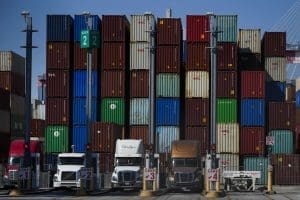Supply chain delays disrupt California agriculture exports
‘California agriculture depends heavily on the exporting of its goods and — I cannot overstate this enough — we are in an urgent position,’ said state Assemblymember Cecilia Aguiar-Curry.

Amid a historic drought posing threats to future harvests, California farmers now say they have no way to export the crops they do have because of a kink in the global supply chain that has left container ships lined up off the Southern California coast with nowhere to deliver their goods.
Problems with the supply chain have retailers worried their shelves — and their customers’ online shopping carts — will be empty during the crucial holiday shopping season, prompting emergency actions from state and federal leaders to clear up the logjam.
But the backlog of ships entering U.S. waters also means there are fewer making the trek back across the Pacific Ocean, leaving the farmers in one of the nation’s most important agriculture regions with nowhere to send their products.
“We’re at the mercy of foreign shipping companies,” said Roger Isom, president and CEO of the California Cotton Ginners and Growers Association and the Western Agricultural Processors Association. “We’re in a game, somebody changed the rules on us and we have no way to correct it.”
California is the nation’s only supplier of tree nuts — almonds, walnuts and pistachios. Most of them are sold to other countries, totaling more than $8.1 billion in exports in 2019, according to the California Department of Food and Agriculture.
But last month, Isom said more than 80% of scheduled shipments were canceled. Processors have resorted to paying much more to ship their products to other ports, sending pistachios and walnuts by train to Texas and Maryland and flying bales of cotton to Peru. Isom said they are losing money on these sales, but they have to do it or else risk losing their customers.
It’s particularly a problem for walnuts, which are in high demand in Europe for the Christmas holiday. But Isom said California’s orders are “now being filled by other countries.”
“One of our members lost $7.5 million in one month of sales because of an inability to fill timely commitments,” Isom told state lawmakers on Wednesday during an informational hearing on the global supply chain problems.
One reason for the shortage of ships is the intense demand for products has driven shipping prices so high that many ocean carriers simply hurry back to Asia once they leave Southern California, bypassing the smaller port in Oakland where most of the state’s tree nuts are shipped.
Danny Wan, executive director of the Port of Oakland and the president of the California Association of Port Authorities, said last week one of the port’s container terminals was empty of both containers and ships.
“The operator tells me this is the first time in the history where they are operating in Oakland where they have not had one vessel call,” Wan said. “This is an example of the supply chain dictating this kind of market distortion.”
But the solution is not as easy as simply turning some ships around in Los Angeles and sending them north to Oakland. Assemblymember Patrick O’Donnell, chair of the Assembly Select Committee on Ports and Goods Movement, said ocean carriers need relationships with terminal operators, trucking companies and warehouses — all of which require contracts to be negotiated.
“That takes time. You can’t just turn on a dime,” he said.
Mike Jacob, vice president and general counsel for the Pacific Merchant Shipping Association, said “it’s important to us” to reestablish shipping connections in ports in both Northern California and the Pacific Northwest, adding three companies have dedicated direct service calls to the Oakland port while two more have plans to start in January.
The Biden administration announced last month the Los Angeles port would soon begin operating 24 hours a day to help clear the backlog of ships. California Gov. Gavin Newsom, a Democrat, has waived some state regulations to allow companies to pack more cargo on trucks.
“In order to solve this problem, every single stakeholder in supply chain have to step up and make difficult choices – including the state,” said Dee Dee Myers, a senior advisor to Newsom and director of the Governor’s Office of Business and Economic Development.
Fruits and nuts are California’s fifth-largest export sector, according to an analysis of trade data by Michigan State University, trailing electrical and industrial machinery and motor vehicles and their parts.
California exports accounted for more than 10% of all U.S. exports in 2020. When it comes to agriculture, California accounted for 16% of all U.S. exports in 2019.
“A great deal of attention is on imports and issues confronting these entities bringing in goods which are important,” said Assemblymember Cecilia Aguiar-Curry, a Democrat whose rural Northern California district includes lots of farmers. “However, California agriculture depends heavily on the exporting of its goods and — I cannot overstate this enough — we are in an urgent position.”
Recommended

Biden calls for expanded child tax credit, taxes on wealthy in $7.2 trillion budget plan
President Joe Biden released his budget request for the upcoming fiscal year Monday, calling on Congress to stick to the spending agreement brokered last year and to revamp tax laws so that the “wealthy pay their fair share.”
By Jennifer Shutt, States Newsroom - March 11, 2024
December jobs report: Wages up, hiring steady as job market ends year strong
Friday’s jobs data showed a strong, resilient U.S. labor market with wages outpacing inflation — welcome news for Americans hoping to have more purchasing power in 2024.
By Casey Quinlan - January 05, 2024
Biden’s infrastructure law is boosting Nevada’s economy. Sam Brown opposed it.
The Nevada Republican U.S. Senate hopeful also spoke out against a rail project projected to create thousands of union jobs
By Jesse Valentine - November 15, 2023









































































